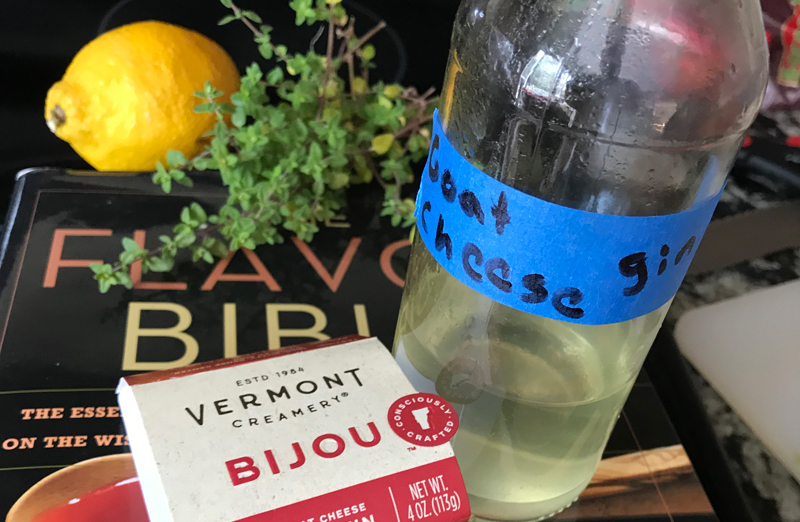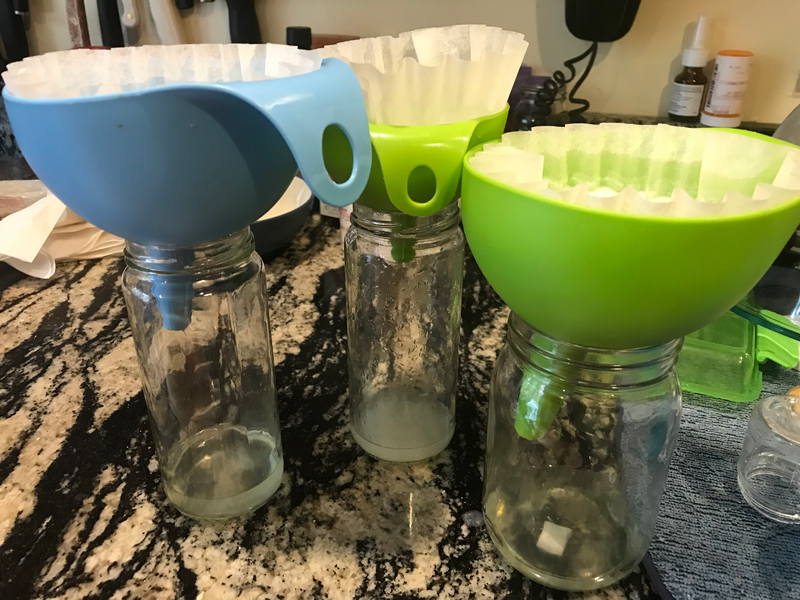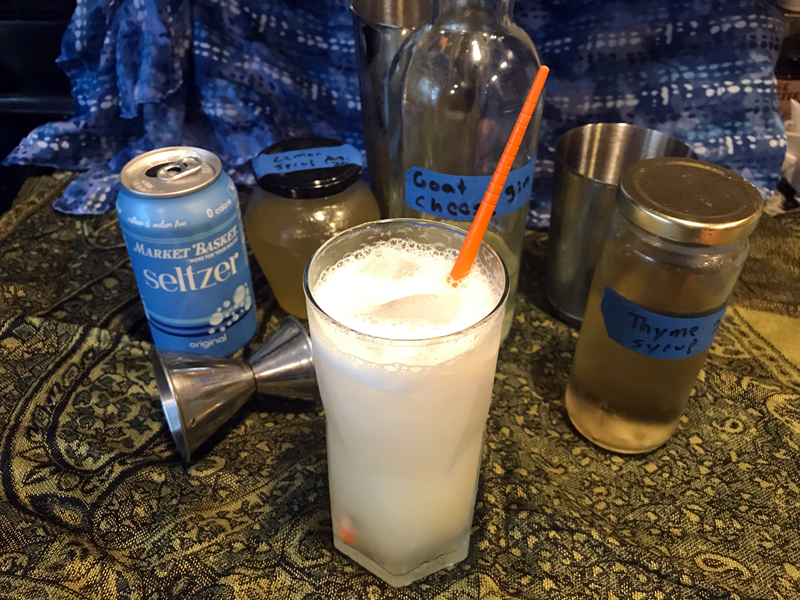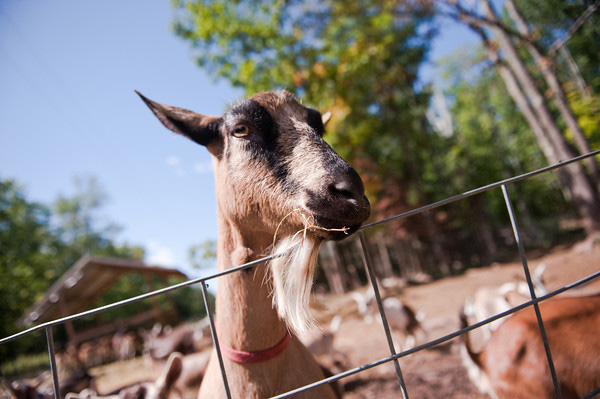PHOTOS BY JOHN FLADD / GOAT PHOTO BY BECCA DILLEY
I wanted to write about using thyme in cocktails.
On the face of it that seems pretty straightforward. Thyme is an herb. People like to cook with it, so presumably it should make a pretty good base for a cocktail. Picking a sprig of thyme from its pot on my deck, I rolled it around in my hands and smelled it.
Piney. A little medicinal. A little like… gin?
So far, so good. Let’s see what my favorite reference book had to say about it.
 The Flavor Bible by Karen Page and Andrew Dornenburg [Little, Brown, and Company, 2008] is an excellent handbook for anyone playing mad scientist in the kitchen. Essentially, it is the result of a very, very comprehensive poll of extremely thoughtful chefs of what flavors they like to pair with particular ingredients. This book gives you a good idea of what the professional consensus is about any given pairing. If, for instance, you wanted to use coffee in a dish, one or two chefs might suggest pairing it with barbecue sauce. Almost all of them though, would suggest using it with chocolate.
The Flavor Bible by Karen Page and Andrew Dornenburg [Little, Brown, and Company, 2008] is an excellent handbook for anyone playing mad scientist in the kitchen. Essentially, it is the result of a very, very comprehensive poll of extremely thoughtful chefs of what flavors they like to pair with particular ingredients. This book gives you a good idea of what the professional consensus is about any given pairing. If, for instance, you wanted to use coffee in a dish, one or two chefs might suggest pairing it with barbecue sauce. Almost all of them though, would suggest using it with chocolate.
Far and away, the chefs suggested pairing thyme with goat cheese.
As did most professionals and home cooks on the internet.
Goat cheese.
How absurd. Clearly, that wouldn’t work in a cocktail. What kind of depraved thrill-seeker would drink a goat cheese cocktail? I would have to try something else.
What else did the chefs suggest to go with thyme?
Carrots, cod, or eggplant.
…
…
So… goat cheese, huh?
I set the idea aside and moved on to other things, but over the next couple of days, goat cheese kept sliding out of my subconscious when my defenses were down. Eventually, a phrase I’d heard once popped into my head.
Fat-washing.
I wasn’t 100 percent sure what it meant, but I seemed to remember that it had something to do with using unlikely foods to flavor alcohol. I looked it up, and although it’s a little more complicated than that, that’s basically what it means. I skimmed through a few blog posts , reading up on it and it seemed straightforward enough, so I thought I’d give it a try. I put a cup or so of gin in a Ziploc bag and crumbled some mild, grocery store chévre into it. I emulsified it by squeezing the bag, then left it to sit for a few hours.
I ended up with cloudy gin that tasted like… gin.
I consulted a cheesemonger, who told me that no, grocery store goat cheese made for suburban wine parties was not going to cut it for this particular use. I needed something extra funky. I needed Sun Ra; I’d used Michael Bolton.
I ended up consulting veteran Minneapolis bartender Marco Zappia (recently of Colita and Martina), who started our conversation by discussing the differences between glycerides, diglycerides, and triglycerides, valence shells, and carbon bonding, then got more technical from there. Eventually, he realized that he wasn’t talking to the brightest gaslight in Paris, and dumbed his concepts down enough for me to wrap my head around them.
The basic theory, he explained, is that almost any compound that is fat-soluble is also alcohol soluble. For the past few years, high-end bartenders have been using that chemical loophole to flavor bourbon with bacon, or rum with brown butter. The secret, he said, was to mix an alcohol with a fatty food, then raise the temperature of the mixture to a couple of degrees above the melting point of the fat you are trying to liberate flavors out of. If you give the fat and alcohol time to get to know each other better, flavors would be exchanged. Goat cheese gin was feasible, if I could be patient enough.
It was as I hung up with Marco that I realized that goat cheese gin had become my white whale – as sad a commentary on my life as I could imagine.
It’s been a couple of weeks and I’ve invested more of my sanity (and goat cheese) into this project than any rational adult should.
But – and here’s the really shocking thing – I’ve cracked it.
Yes, it is possible to infuse gin with goat cheese.
Here’s how to do it:
Step 1 – Combine gin and goat cheese in a sealable plastic bag. Use two ounces of the stinkiest… er… most assertive soft goat cheese you can find for each cup of gin. (I used a Bijou crottin from Vermont Creamery, which was almost ripe enough to trigger hallucinations.) If you do this right, any subtle botanical flavors in the gin will be completely overpowered by the flavor of the cheese, so a basic, garden-variety gin will be fine for this. I used Gordon’s.
Smoosh the bag until the cheese is completely dissolved in the gin. Grope it shamelessly.
 Step 2 – Give the bag a soak in a water bath just above the melting point of the cheese. (I contacted the dairy and their lab guy gave me guidance on this. It turns out that almost all soft goat cheeses melt at about 120°F/49°C.) Let it soak for three to four hours, with the lip of the bag hanging over the edge of the bath, to avoid leaks.
Step 2 – Give the bag a soak in a water bath just above the melting point of the cheese. (I contacted the dairy and their lab guy gave me guidance on this. It turns out that almost all soft goat cheeses melt at about 120°F/49°C.) Let it soak for three to four hours, with the lip of the bag hanging over the edge of the bath, to avoid leaks.
A brief aside here:
As I worked diligently at this for the next four hours, I kept thinking, “You know what would make this MUCH easier?”
I’d like to start the next sentence with, “After some discussion,” but the truth is that there was very little discussion. My wife let me know that in light of some recent, ill-advised online purchases, I was NOT going to buy a sous vide tank. Nor a laboratory-grade centrifuge. This struck me as unfair, and not a little hypocritical. She married me many years ago in the spirit of a fixer-upper; one would think she would have more sympathy for this sort of project.
Although, to be fair, look at how that project turned out for her.
I ended up using an enameled Dutch oven with a good thermal mass. (A small cooler would work well, too.) I put it on a heating pad to slow the cooling of the water bath, and used a probe thermometer to keep an eye on the water temperature. I filled the pot halfway with very hot water, then every time the temperature fell below 120°, I’d add a couple of cups of boiling water to bump it back up to 130° or so.
Step 3 – After a four hour soak, remove the bag of cheese gin from its bath and put it in a bowl somewhere out of the way for 72 hours. Once or twice per day, you might want to smoosh the bag around in your hands to remix the infusion and keep the cheese in solution.
Step 4 – On the big day, thank your bag of gin for working so hard for you, then strain it through a fine meshed strainer. There will be a surprising amount of cheese solids – or casein – left behind.
 Step 5 – Filter the cloudy liquid through a coffee filter. To make the process more efficient, I split the batch between several jars with funnels fitted out with the filters.
Step 5 – Filter the cloudy liquid through a coffee filter. To make the process more efficient, I split the batch between several jars with funnels fitted out with the filters.
The secret here is to walk away.
Seriously – the baby gin will take forever to work its way through the filter, and if you hang around, you will be tempted to play with it. Don’t do that.
Just walk away.
In the end, you will be left with a clear, slightly golden-colored gin that is satisfyingly earthy, and identifiably goaty. It tastes like goat cheese! As you taste it, it has a multi-stage flavor that makes your (well, okay – my) eyes widen. It doesn’t knock you over with barnyard flavor, but the goats in its past definitely speak to you.
The infusion process smooths the gin out considerably. It would be excellent in a little cordial glass with a piece of sourdough toast. Alternatively, here are a pair of goat-forward cocktails that you won’t find anywhere else:
The Relentless March of Thyme
2 oz. goat cheese infused gin
1 oz. fresh lemon juice
1/2 oz. thyme simple syrup (see below)
4-5 sprigs of fresh thyme
Add all ingredients, with ice, to a cocktail shaker and shake it brutally, until your hands start to hurt from the cold and you can hear the ice splintering.
Strain into a martini glass and garnish with another sprig of fresh thyme.
This is a goat-forward, thyme-y, martini-like cocktail. It has a bit of sweetness from the thyme syrup, but it has a clean, cold taste that picks up on the multi-stage nature of the gin and comes in waves.
Thyme Simple Syrup
(Stop rolling your eyes. If you’ve gone this far, you can invest another half an hour into making some syrup.)
1 cup sugar
1 cup water
1/2 cup fresh thyme, loosely packed
Add all three ingredients to a small pot and boil until the sugar is completely dissolved – 2-3 minutes. Remove from heat, cover the pot and let the thyme steep for ~30 minutes.
Strain the syrup into a bottle, label it, and refrigerate it.
 Die Goat-erdämmerung
Die Goat-erdämmerung
2 oz. goat cheese infused gin
1 oz. thyme simple syrup
1 oz. lemon syrup (see below)
Plain seltzer
Add gin, thyme syrup and lemon syrup to a cocktail shaker, with ice.
Again, shake brutally, until the ice shatters, or the world ends.
Pour, with ice, into a tall glass. Top with seltzer. Stir gently.
This take on goat-cheese gin is sweeter and more amiable than its martini-sh baby brother. Instead of shouting, “HEY!! GOAT CHEESE!!” at you, it soothes and persuades you – “Oh, this is lovely. Oh, there’s some lemon; you like that, don’t you? What’s that in the background? Thyme, you say? Oh, that’s perfect. You know, this is just goaty enough.” It is perfect for sitting on the porch during the last few warm days of Fall.
Lemon Syrup
(At this point, you’ve invested a week or so into this project. Go ahead and make the lemon syrup.)
1 part lemon juice (4 lemons gave me 1½ cups)
1 part sugar
pinch of salt
Zest of 1 lemon
Boil lemon juice, sugar, and salt, until the sugar dissolves.
Remove from heat. Add lemon zest; steep for ~30 minutes.
Strain, bottle, and label.
“All my means are sane, my motive and my object mad.” — Herman Melville, Moby Dick

